Analyzing Leadership's Impact on Organizational Productivity
VerifiedAdded on 2020/05/04
|12
|3189
|94
Report
AI Summary
This report investigates the significant impact of leadership on organizational productivity, particularly within the healthcare sector. It explores key elements such as employee engagement, job satisfaction, and performance, highlighting how effective leadership, especially transformational leadership, fosters a positive work environment. The report examines how leadership influences team building, employee behavior, and overall organizational outcomes. It also identifies barriers to leadership development, including funding limitations and organizational structure issues. Furthermore, the report provides actionable recommendations, such as providing comprehensive training and allocating sufficient resources, to enhance leadership effectiveness and drive improved productivity within healthcare organizations. The report uses case studies from various hospitals to support its findings.
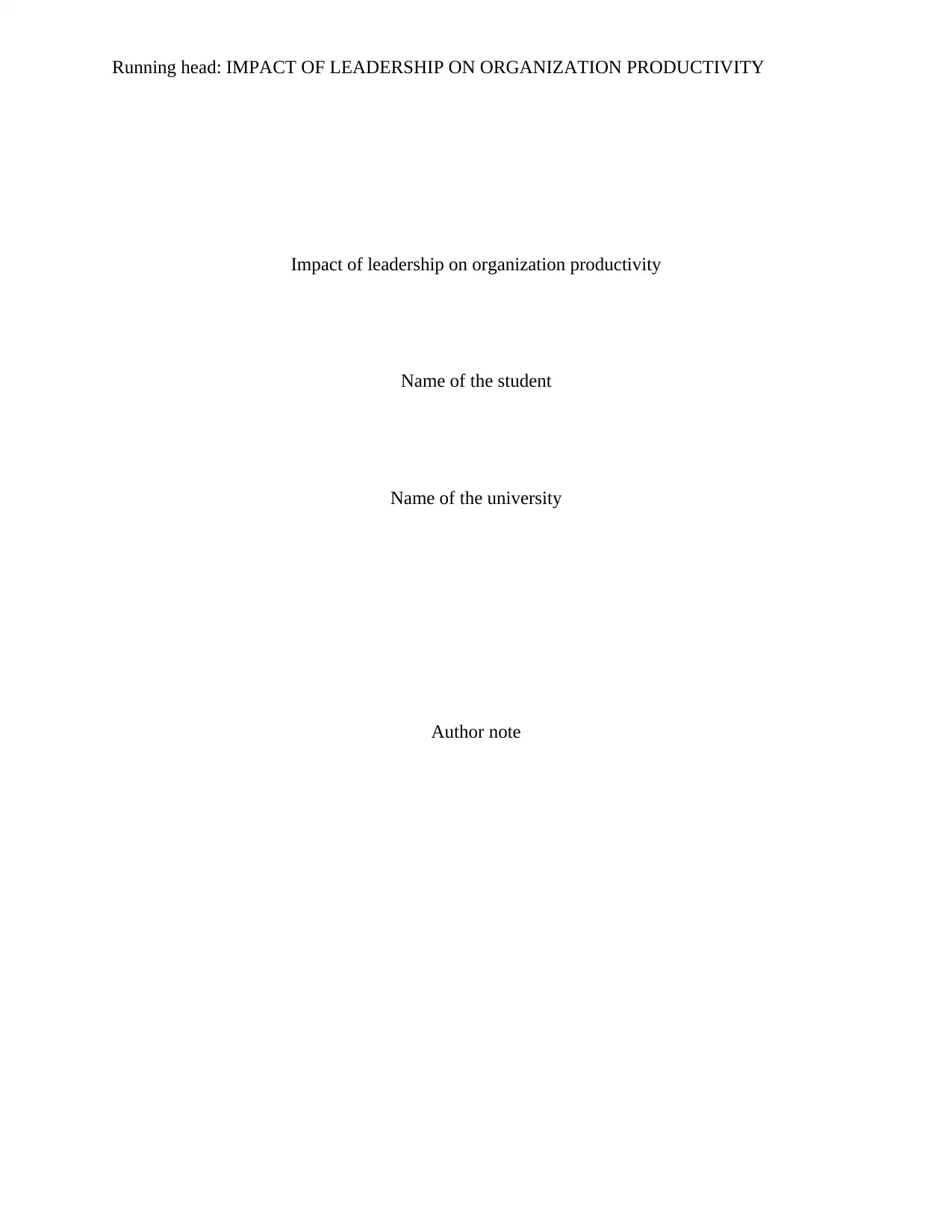
Running head: IMPACT OF LEADERSHIP ON ORGANIZATION PRODUCTIVITY
Impact of leadership on organization productivity
Name of the student
Name of the university
Author note
Impact of leadership on organization productivity
Name of the student
Name of the university
Author note
Paraphrase This Document
Need a fresh take? Get an instant paraphrase of this document with our AI Paraphraser
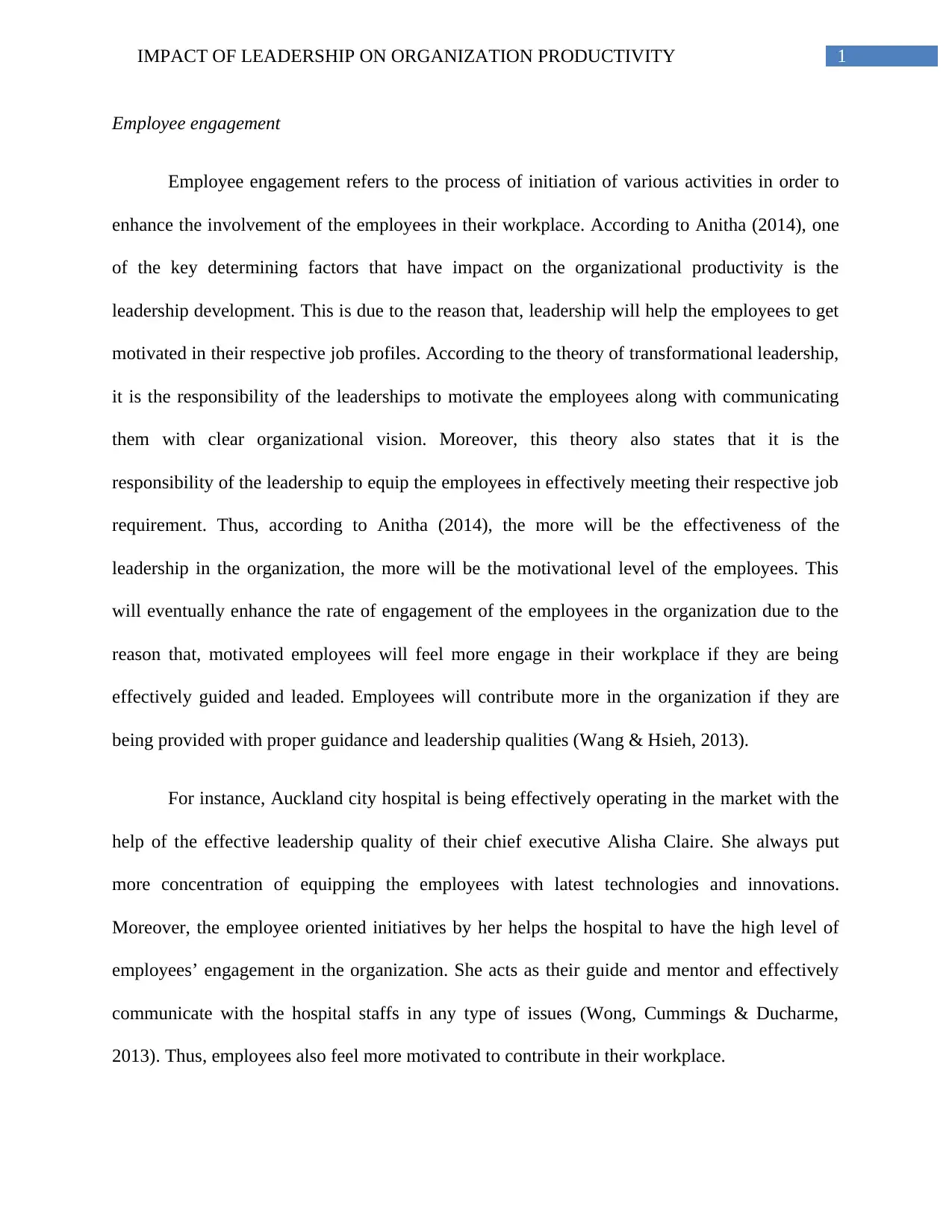
1IMPACT OF LEADERSHIP ON ORGANIZATION PRODUCTIVITY
Employee engagement
Employee engagement refers to the process of initiation of various activities in order to
enhance the involvement of the employees in their workplace. According to Anitha (2014), one
of the key determining factors that have impact on the organizational productivity is the
leadership development. This is due to the reason that, leadership will help the employees to get
motivated in their respective job profiles. According to the theory of transformational leadership,
it is the responsibility of the leaderships to motivate the employees along with communicating
them with clear organizational vision. Moreover, this theory also states that it is the
responsibility of the leadership to equip the employees in effectively meeting their respective job
requirement. Thus, according to Anitha (2014), the more will be the effectiveness of the
leadership in the organization, the more will be the motivational level of the employees. This
will eventually enhance the rate of engagement of the employees in the organization due to the
reason that, motivated employees will feel more engage in their workplace if they are being
effectively guided and leaded. Employees will contribute more in the organization if they are
being provided with proper guidance and leadership qualities (Wang & Hsieh, 2013).
For instance, Auckland city hospital is being effectively operating in the market with the
help of the effective leadership quality of their chief executive Alisha Claire. She always put
more concentration of equipping the employees with latest technologies and innovations.
Moreover, the employee oriented initiatives by her helps the hospital to have the high level of
employees’ engagement in the organization. She acts as their guide and mentor and effectively
communicate with the hospital staffs in any type of issues (Wong, Cummings & Ducharme,
2013). Thus, employees also feel more motivated to contribute in their workplace.
Employee engagement
Employee engagement refers to the process of initiation of various activities in order to
enhance the involvement of the employees in their workplace. According to Anitha (2014), one
of the key determining factors that have impact on the organizational productivity is the
leadership development. This is due to the reason that, leadership will help the employees to get
motivated in their respective job profiles. According to the theory of transformational leadership,
it is the responsibility of the leaderships to motivate the employees along with communicating
them with clear organizational vision. Moreover, this theory also states that it is the
responsibility of the leadership to equip the employees in effectively meeting their respective job
requirement. Thus, according to Anitha (2014), the more will be the effectiveness of the
leadership in the organization, the more will be the motivational level of the employees. This
will eventually enhance the rate of engagement of the employees in the organization due to the
reason that, motivated employees will feel more engage in their workplace if they are being
effectively guided and leaded. Employees will contribute more in the organization if they are
being provided with proper guidance and leadership qualities (Wang & Hsieh, 2013).
For instance, Auckland city hospital is being effectively operating in the market with the
help of the effective leadership quality of their chief executive Alisha Claire. She always put
more concentration of equipping the employees with latest technologies and innovations.
Moreover, the employee oriented initiatives by her helps the hospital to have the high level of
employees’ engagement in the organization. She acts as their guide and mentor and effectively
communicate with the hospital staffs in any type of issues (Wong, Cummings & Ducharme,
2013). Thus, employees also feel more motivated to contribute in their workplace.
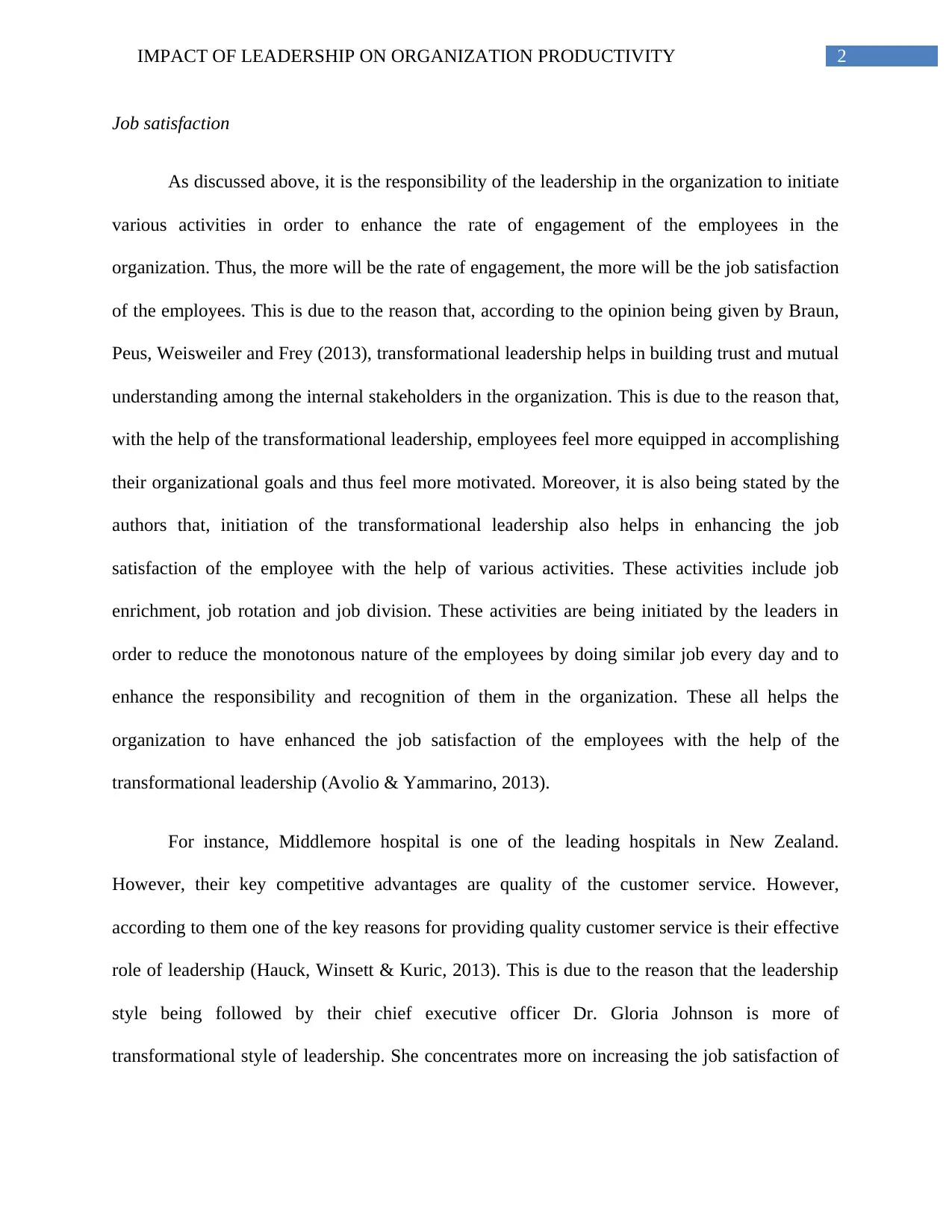
2IMPACT OF LEADERSHIP ON ORGANIZATION PRODUCTIVITY
Job satisfaction
As discussed above, it is the responsibility of the leadership in the organization to initiate
various activities in order to enhance the rate of engagement of the employees in the
organization. Thus, the more will be the rate of engagement, the more will be the job satisfaction
of the employees. This is due to the reason that, according to the opinion being given by Braun,
Peus, Weisweiler and Frey (2013), transformational leadership helps in building trust and mutual
understanding among the internal stakeholders in the organization. This is due to the reason that,
with the help of the transformational leadership, employees feel more equipped in accomplishing
their organizational goals and thus feel more motivated. Moreover, it is also being stated by the
authors that, initiation of the transformational leadership also helps in enhancing the job
satisfaction of the employee with the help of various activities. These activities include job
enrichment, job rotation and job division. These activities are being initiated by the leaders in
order to reduce the monotonous nature of the employees by doing similar job every day and to
enhance the responsibility and recognition of them in the organization. These all helps the
organization to have enhanced the job satisfaction of the employees with the help of the
transformational leadership (Avolio & Yammarino, 2013).
For instance, Middlemore hospital is one of the leading hospitals in New Zealand.
However, their key competitive advantages are quality of the customer service. However,
according to them one of the key reasons for providing quality customer service is their effective
role of leadership (Hauck, Winsett & Kuric, 2013). This is due to the reason that the leadership
style being followed by their chief executive officer Dr. Gloria Johnson is more of
transformational style of leadership. She concentrates more on increasing the job satisfaction of
Job satisfaction
As discussed above, it is the responsibility of the leadership in the organization to initiate
various activities in order to enhance the rate of engagement of the employees in the
organization. Thus, the more will be the rate of engagement, the more will be the job satisfaction
of the employees. This is due to the reason that, according to the opinion being given by Braun,
Peus, Weisweiler and Frey (2013), transformational leadership helps in building trust and mutual
understanding among the internal stakeholders in the organization. This is due to the reason that,
with the help of the transformational leadership, employees feel more equipped in accomplishing
their organizational goals and thus feel more motivated. Moreover, it is also being stated by the
authors that, initiation of the transformational leadership also helps in enhancing the job
satisfaction of the employee with the help of various activities. These activities include job
enrichment, job rotation and job division. These activities are being initiated by the leaders in
order to reduce the monotonous nature of the employees by doing similar job every day and to
enhance the responsibility and recognition of them in the organization. These all helps the
organization to have enhanced the job satisfaction of the employees with the help of the
transformational leadership (Avolio & Yammarino, 2013).
For instance, Middlemore hospital is one of the leading hospitals in New Zealand.
However, their key competitive advantages are quality of the customer service. However,
according to them one of the key reasons for providing quality customer service is their effective
role of leadership (Hauck, Winsett & Kuric, 2013). This is due to the reason that the leadership
style being followed by their chief executive officer Dr. Gloria Johnson is more of
transformational style of leadership. She concentrates more on increasing the job satisfaction of
⊘ This is a preview!⊘
Do you want full access?
Subscribe today to unlock all pages.

Trusted by 1+ million students worldwide
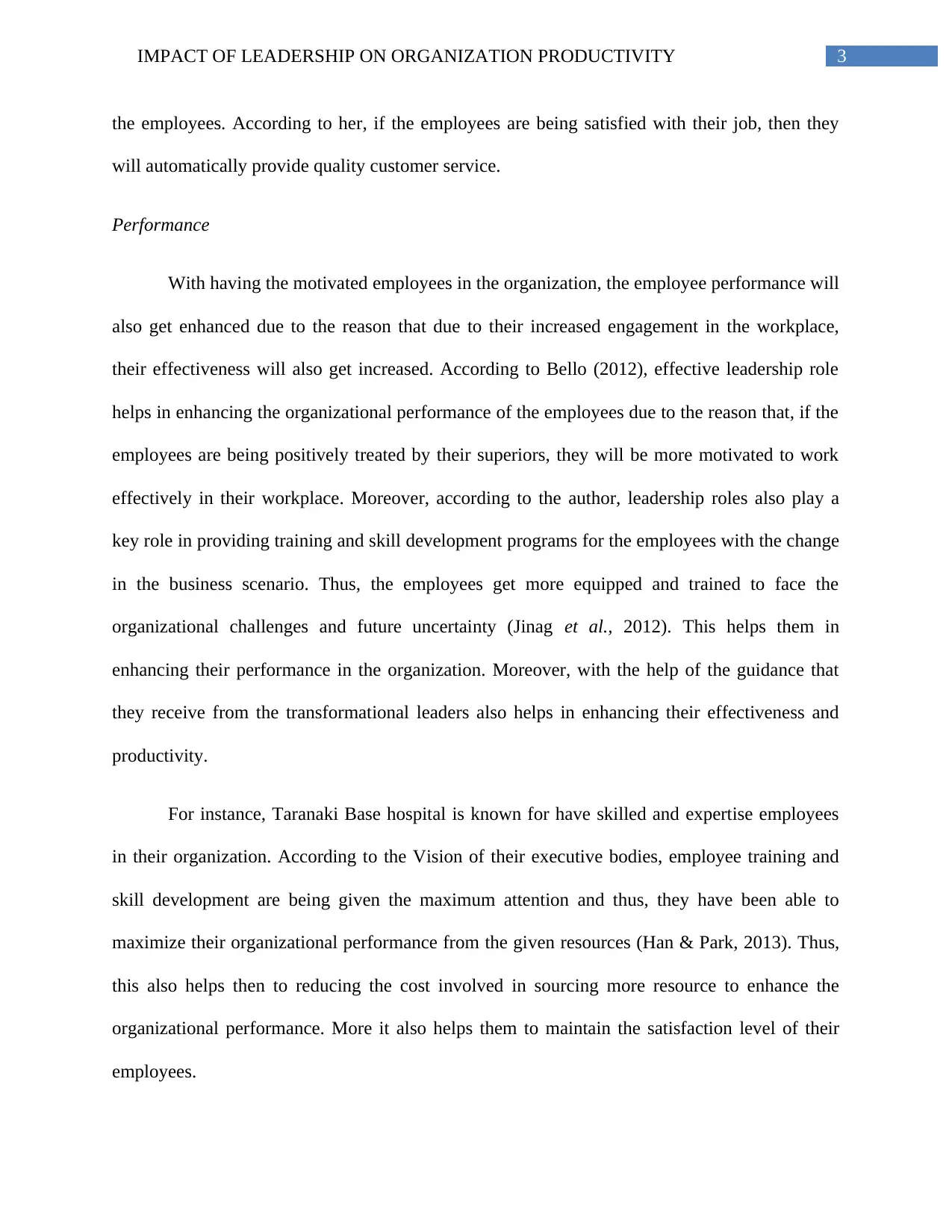
3IMPACT OF LEADERSHIP ON ORGANIZATION PRODUCTIVITY
the employees. According to her, if the employees are being satisfied with their job, then they
will automatically provide quality customer service.
Performance
With having the motivated employees in the organization, the employee performance will
also get enhanced due to the reason that due to their increased engagement in the workplace,
their effectiveness will also get increased. According to Bello (2012), effective leadership role
helps in enhancing the organizational performance of the employees due to the reason that, if the
employees are being positively treated by their superiors, they will be more motivated to work
effectively in their workplace. Moreover, according to the author, leadership roles also play a
key role in providing training and skill development programs for the employees with the change
in the business scenario. Thus, the employees get more equipped and trained to face the
organizational challenges and future uncertainty (Jinag et al., 2012). This helps them in
enhancing their performance in the organization. Moreover, with the help of the guidance that
they receive from the transformational leaders also helps in enhancing their effectiveness and
productivity.
For instance, Taranaki Base hospital is known for have skilled and expertise employees
in their organization. According to the Vision of their executive bodies, employee training and
skill development are being given the maximum attention and thus, they have been able to
maximize their organizational performance from the given resources (Han & Park, 2013). Thus,
this also helps then to reducing the cost involved in sourcing more resource to enhance the
organizational performance. More it also helps them to maintain the satisfaction level of their
employees.
the employees. According to her, if the employees are being satisfied with their job, then they
will automatically provide quality customer service.
Performance
With having the motivated employees in the organization, the employee performance will
also get enhanced due to the reason that due to their increased engagement in the workplace,
their effectiveness will also get increased. According to Bello (2012), effective leadership role
helps in enhancing the organizational performance of the employees due to the reason that, if the
employees are being positively treated by their superiors, they will be more motivated to work
effectively in their workplace. Moreover, according to the author, leadership roles also play a
key role in providing training and skill development programs for the employees with the change
in the business scenario. Thus, the employees get more equipped and trained to face the
organizational challenges and future uncertainty (Jinag et al., 2012). This helps them in
enhancing their performance in the organization. Moreover, with the help of the guidance that
they receive from the transformational leaders also helps in enhancing their effectiveness and
productivity.
For instance, Taranaki Base hospital is known for have skilled and expertise employees
in their organization. According to the Vision of their executive bodies, employee training and
skill development are being given the maximum attention and thus, they have been able to
maximize their organizational performance from the given resources (Han & Park, 2013). Thus,
this also helps then to reducing the cost involved in sourcing more resource to enhance the
organizational performance. More it also helps them to maintain the satisfaction level of their
employees.
Paraphrase This Document
Need a fresh take? Get an instant paraphrase of this document with our AI Paraphraser
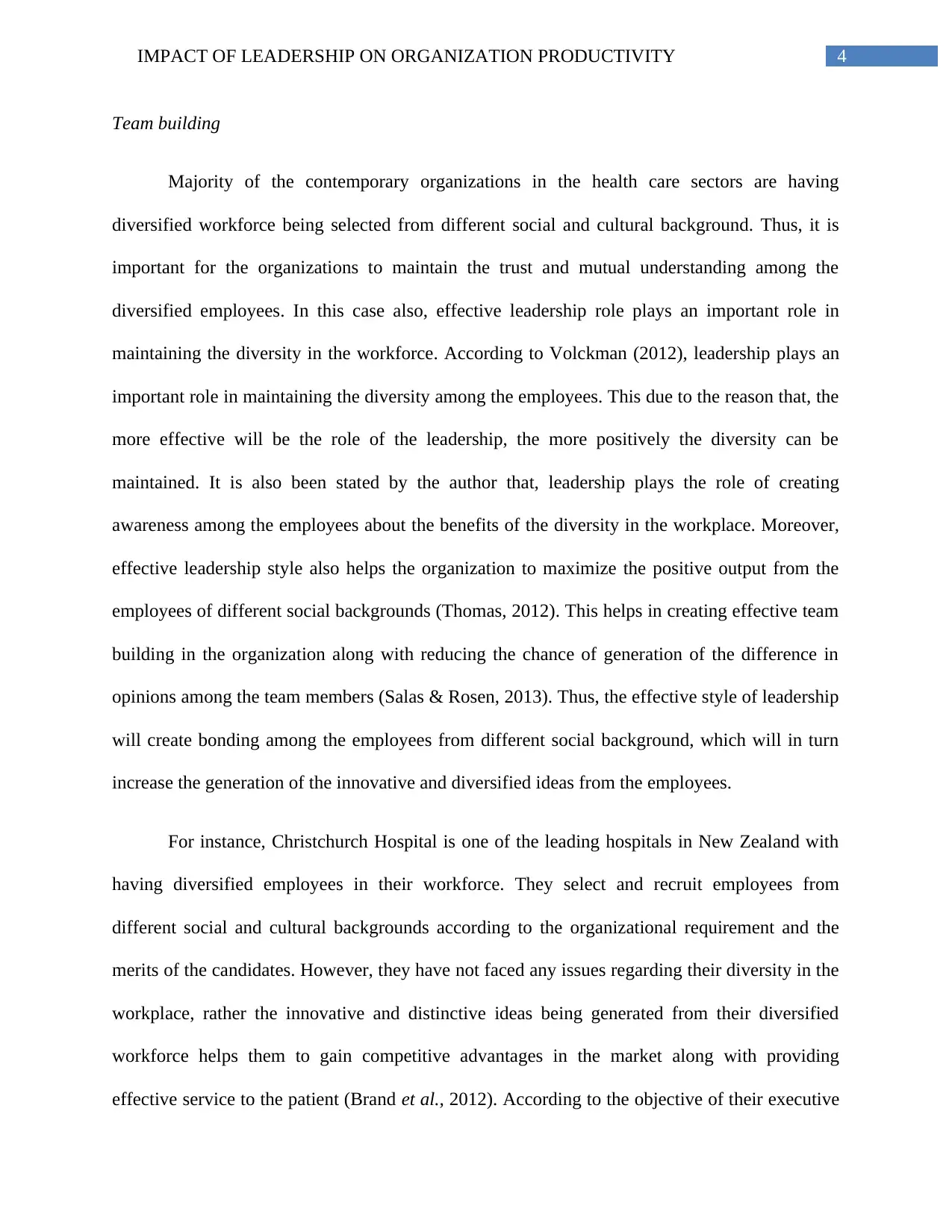
4IMPACT OF LEADERSHIP ON ORGANIZATION PRODUCTIVITY
Team building
Majority of the contemporary organizations in the health care sectors are having
diversified workforce being selected from different social and cultural background. Thus, it is
important for the organizations to maintain the trust and mutual understanding among the
diversified employees. In this case also, effective leadership role plays an important role in
maintaining the diversity in the workforce. According to Volckman (2012), leadership plays an
important role in maintaining the diversity among the employees. This due to the reason that, the
more effective will be the role of the leadership, the more positively the diversity can be
maintained. It is also been stated by the author that, leadership plays the role of creating
awareness among the employees about the benefits of the diversity in the workplace. Moreover,
effective leadership style also helps the organization to maximize the positive output from the
employees of different social backgrounds (Thomas, 2012). This helps in creating effective team
building in the organization along with reducing the chance of generation of the difference in
opinions among the team members (Salas & Rosen, 2013). Thus, the effective style of leadership
will create bonding among the employees from different social background, which will in turn
increase the generation of the innovative and diversified ideas from the employees.
For instance, Christchurch Hospital is one of the leading hospitals in New Zealand with
having diversified employees in their workforce. They select and recruit employees from
different social and cultural backgrounds according to the organizational requirement and the
merits of the candidates. However, they have not faced any issues regarding their diversity in the
workplace, rather the innovative and distinctive ideas being generated from their diversified
workforce helps them to gain competitive advantages in the market along with providing
effective service to the patient (Brand et al., 2012). According to the objective of their executive
Team building
Majority of the contemporary organizations in the health care sectors are having
diversified workforce being selected from different social and cultural background. Thus, it is
important for the organizations to maintain the trust and mutual understanding among the
diversified employees. In this case also, effective leadership role plays an important role in
maintaining the diversity in the workforce. According to Volckman (2012), leadership plays an
important role in maintaining the diversity among the employees. This due to the reason that, the
more effective will be the role of the leadership, the more positively the diversity can be
maintained. It is also been stated by the author that, leadership plays the role of creating
awareness among the employees about the benefits of the diversity in the workplace. Moreover,
effective leadership style also helps the organization to maximize the positive output from the
employees of different social backgrounds (Thomas, 2012). This helps in creating effective team
building in the organization along with reducing the chance of generation of the difference in
opinions among the team members (Salas & Rosen, 2013). Thus, the effective style of leadership
will create bonding among the employees from different social background, which will in turn
increase the generation of the innovative and diversified ideas from the employees.
For instance, Christchurch Hospital is one of the leading hospitals in New Zealand with
having diversified employees in their workforce. They select and recruit employees from
different social and cultural backgrounds according to the organizational requirement and the
merits of the candidates. However, they have not faced any issues regarding their diversity in the
workplace, rather the innovative and distinctive ideas being generated from their diversified
workforce helps them to gain competitive advantages in the market along with providing
effective service to the patient (Brand et al., 2012). According to the objective of their executive
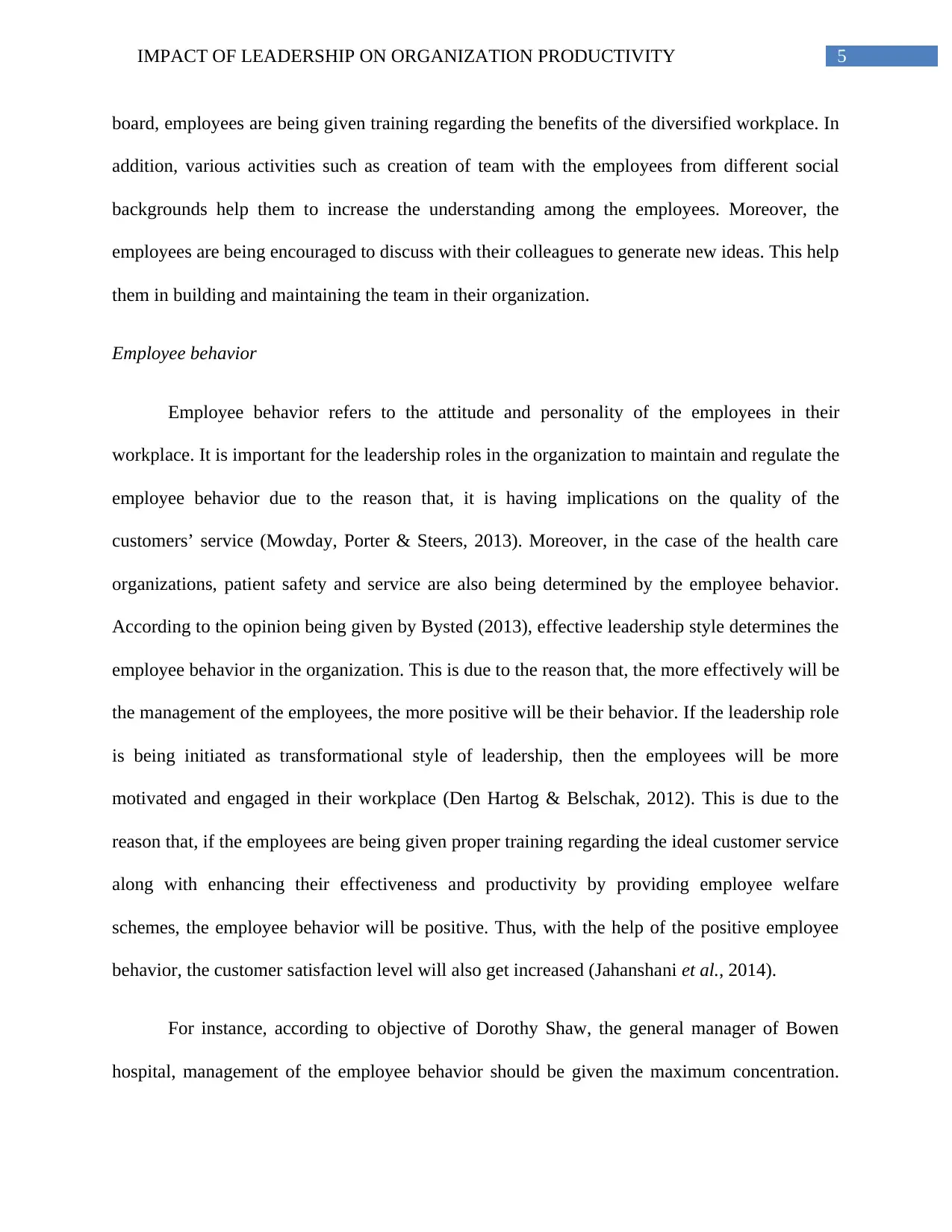
5IMPACT OF LEADERSHIP ON ORGANIZATION PRODUCTIVITY
board, employees are being given training regarding the benefits of the diversified workplace. In
addition, various activities such as creation of team with the employees from different social
backgrounds help them to increase the understanding among the employees. Moreover, the
employees are being encouraged to discuss with their colleagues to generate new ideas. This help
them in building and maintaining the team in their organization.
Employee behavior
Employee behavior refers to the attitude and personality of the employees in their
workplace. It is important for the leadership roles in the organization to maintain and regulate the
employee behavior due to the reason that, it is having implications on the quality of the
customers’ service (Mowday, Porter & Steers, 2013). Moreover, in the case of the health care
organizations, patient safety and service are also being determined by the employee behavior.
According to the opinion being given by Bysted (2013), effective leadership style determines the
employee behavior in the organization. This is due to the reason that, the more effectively will be
the management of the employees, the more positive will be their behavior. If the leadership role
is being initiated as transformational style of leadership, then the employees will be more
motivated and engaged in their workplace (Den Hartog & Belschak, 2012). This is due to the
reason that, if the employees are being given proper training regarding the ideal customer service
along with enhancing their effectiveness and productivity by providing employee welfare
schemes, the employee behavior will be positive. Thus, with the help of the positive employee
behavior, the customer satisfaction level will also get increased (Jahanshani et al., 2014).
For instance, according to objective of Dorothy Shaw, the general manager of Bowen
hospital, management of the employee behavior should be given the maximum concentration.
board, employees are being given training regarding the benefits of the diversified workplace. In
addition, various activities such as creation of team with the employees from different social
backgrounds help them to increase the understanding among the employees. Moreover, the
employees are being encouraged to discuss with their colleagues to generate new ideas. This help
them in building and maintaining the team in their organization.
Employee behavior
Employee behavior refers to the attitude and personality of the employees in their
workplace. It is important for the leadership roles in the organization to maintain and regulate the
employee behavior due to the reason that, it is having implications on the quality of the
customers’ service (Mowday, Porter & Steers, 2013). Moreover, in the case of the health care
organizations, patient safety and service are also being determined by the employee behavior.
According to the opinion being given by Bysted (2013), effective leadership style determines the
employee behavior in the organization. This is due to the reason that, the more effectively will be
the management of the employees, the more positive will be their behavior. If the leadership role
is being initiated as transformational style of leadership, then the employees will be more
motivated and engaged in their workplace (Den Hartog & Belschak, 2012). This is due to the
reason that, if the employees are being given proper training regarding the ideal customer service
along with enhancing their effectiveness and productivity by providing employee welfare
schemes, the employee behavior will be positive. Thus, with the help of the positive employee
behavior, the customer satisfaction level will also get increased (Jahanshani et al., 2014).
For instance, according to objective of Dorothy Shaw, the general manager of Bowen
hospital, management of the employee behavior should be given the maximum concentration.
⊘ This is a preview!⊘
Do you want full access?
Subscribe today to unlock all pages.

Trusted by 1+ million students worldwide
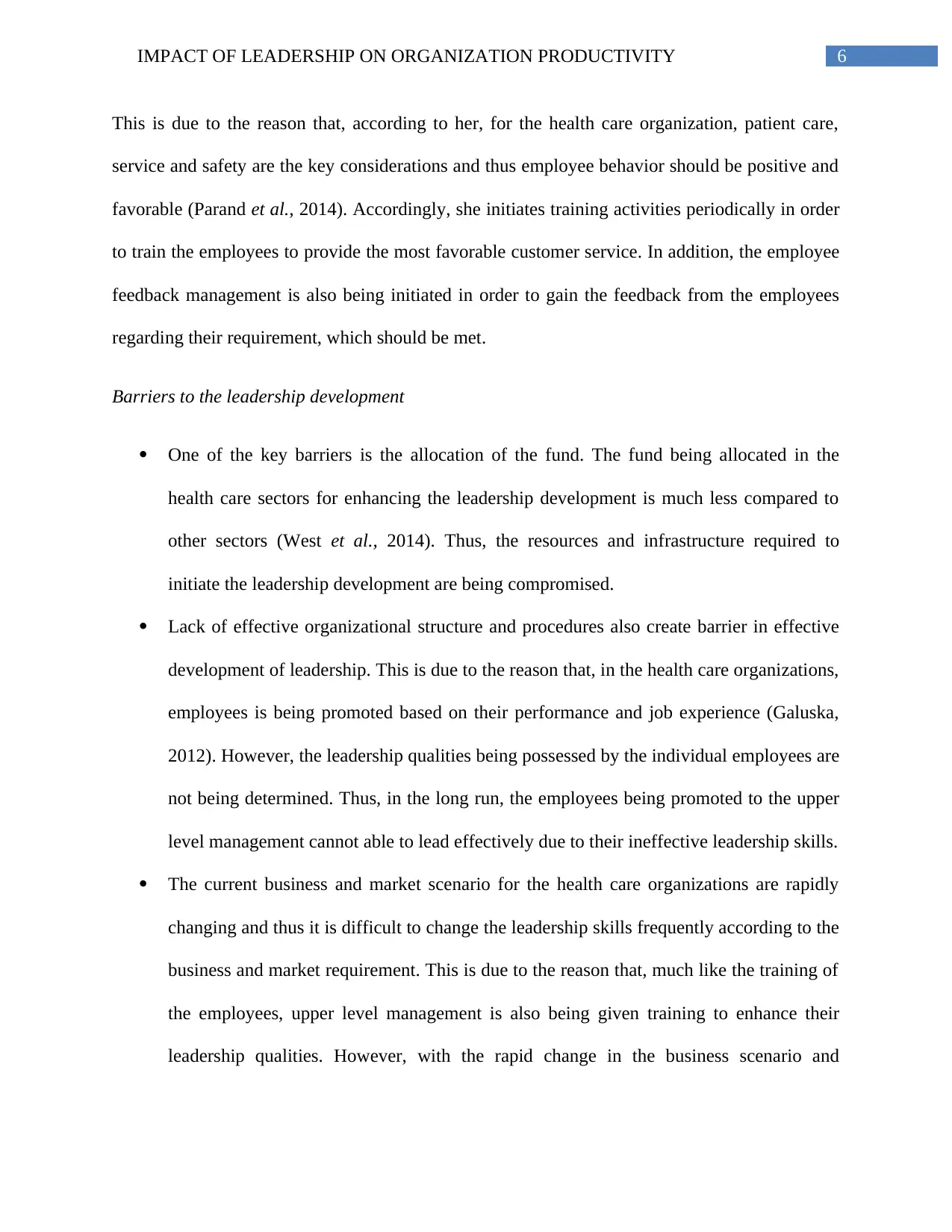
6IMPACT OF LEADERSHIP ON ORGANIZATION PRODUCTIVITY
This is due to the reason that, according to her, for the health care organization, patient care,
service and safety are the key considerations and thus employee behavior should be positive and
favorable (Parand et al., 2014). Accordingly, she initiates training activities periodically in order
to train the employees to provide the most favorable customer service. In addition, the employee
feedback management is also being initiated in order to gain the feedback from the employees
regarding their requirement, which should be met.
Barriers to the leadership development
One of the key barriers is the allocation of the fund. The fund being allocated in the
health care sectors for enhancing the leadership development is much less compared to
other sectors (West et al., 2014). Thus, the resources and infrastructure required to
initiate the leadership development are being compromised.
Lack of effective organizational structure and procedures also create barrier in effective
development of leadership. This is due to the reason that, in the health care organizations,
employees is being promoted based on their performance and job experience (Galuska,
2012). However, the leadership qualities being possessed by the individual employees are
not being determined. Thus, in the long run, the employees being promoted to the upper
level management cannot able to lead effectively due to their ineffective leadership skills.
The current business and market scenario for the health care organizations are rapidly
changing and thus it is difficult to change the leadership skills frequently according to the
business and market requirement. This is due to the reason that, much like the training of
the employees, upper level management is also being given training to enhance their
leadership qualities. However, with the rapid change in the business scenario and
This is due to the reason that, according to her, for the health care organization, patient care,
service and safety are the key considerations and thus employee behavior should be positive and
favorable (Parand et al., 2014). Accordingly, she initiates training activities periodically in order
to train the employees to provide the most favorable customer service. In addition, the employee
feedback management is also being initiated in order to gain the feedback from the employees
regarding their requirement, which should be met.
Barriers to the leadership development
One of the key barriers is the allocation of the fund. The fund being allocated in the
health care sectors for enhancing the leadership development is much less compared to
other sectors (West et al., 2014). Thus, the resources and infrastructure required to
initiate the leadership development are being compromised.
Lack of effective organizational structure and procedures also create barrier in effective
development of leadership. This is due to the reason that, in the health care organizations,
employees is being promoted based on their performance and job experience (Galuska,
2012). However, the leadership qualities being possessed by the individual employees are
not being determined. Thus, in the long run, the employees being promoted to the upper
level management cannot able to lead effectively due to their ineffective leadership skills.
The current business and market scenario for the health care organizations are rapidly
changing and thus it is difficult to change the leadership skills frequently according to the
business and market requirement. This is due to the reason that, much like the training of
the employees, upper level management is also being given training to enhance their
leadership qualities. However, with the rapid change in the business scenario and
Paraphrase This Document
Need a fresh take? Get an instant paraphrase of this document with our AI Paraphraser
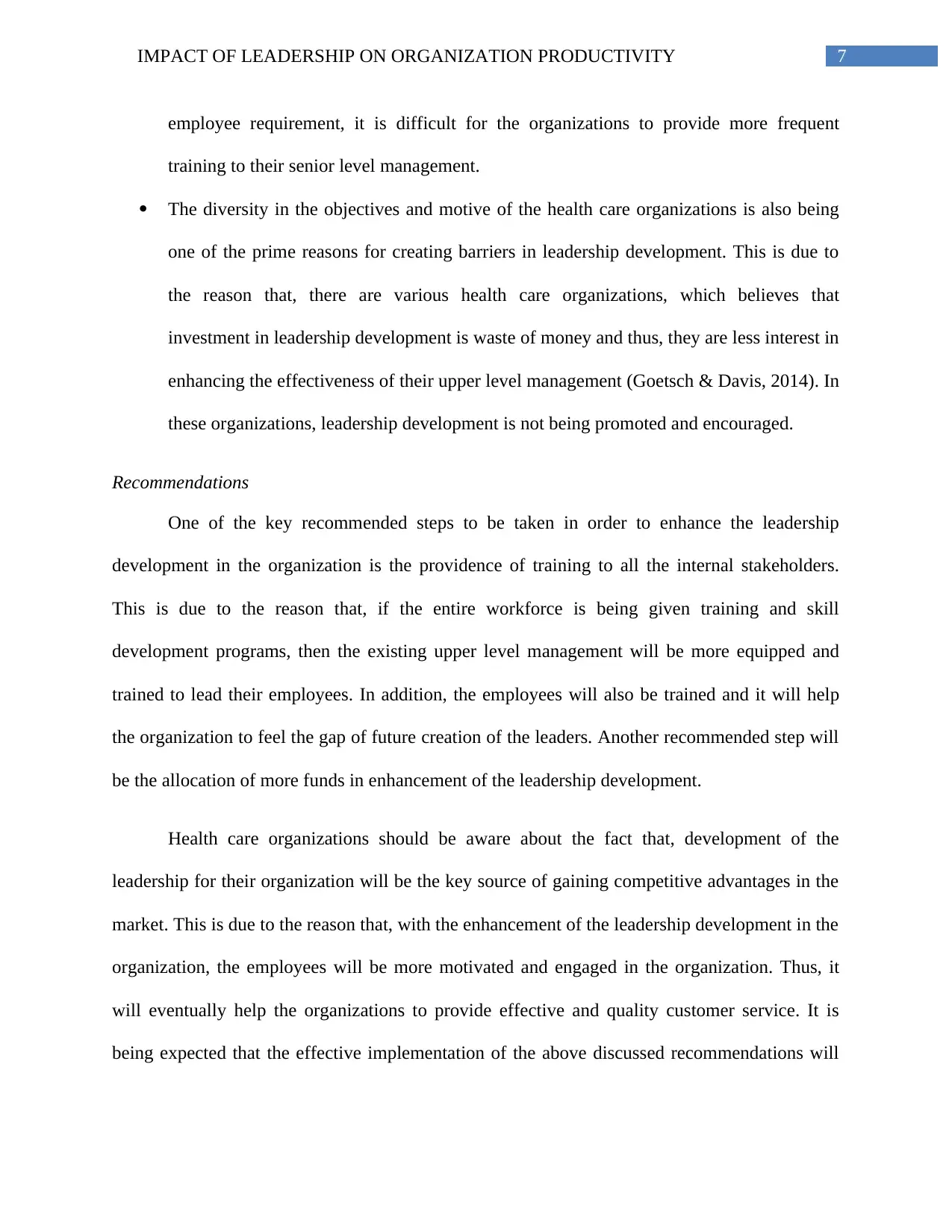
7IMPACT OF LEADERSHIP ON ORGANIZATION PRODUCTIVITY
employee requirement, it is difficult for the organizations to provide more frequent
training to their senior level management.
The diversity in the objectives and motive of the health care organizations is also being
one of the prime reasons for creating barriers in leadership development. This is due to
the reason that, there are various health care organizations, which believes that
investment in leadership development is waste of money and thus, they are less interest in
enhancing the effectiveness of their upper level management (Goetsch & Davis, 2014). In
these organizations, leadership development is not being promoted and encouraged.
Recommendations
One of the key recommended steps to be taken in order to enhance the leadership
development in the organization is the providence of training to all the internal stakeholders.
This is due to the reason that, if the entire workforce is being given training and skill
development programs, then the existing upper level management will be more equipped and
trained to lead their employees. In addition, the employees will also be trained and it will help
the organization to feel the gap of future creation of the leaders. Another recommended step will
be the allocation of more funds in enhancement of the leadership development.
Health care organizations should be aware about the fact that, development of the
leadership for their organization will be the key source of gaining competitive advantages in the
market. This is due to the reason that, with the enhancement of the leadership development in the
organization, the employees will be more motivated and engaged in the organization. Thus, it
will eventually help the organizations to provide effective and quality customer service. It is
being expected that the effective implementation of the above discussed recommendations will
employee requirement, it is difficult for the organizations to provide more frequent
training to their senior level management.
The diversity in the objectives and motive of the health care organizations is also being
one of the prime reasons for creating barriers in leadership development. This is due to
the reason that, there are various health care organizations, which believes that
investment in leadership development is waste of money and thus, they are less interest in
enhancing the effectiveness of their upper level management (Goetsch & Davis, 2014). In
these organizations, leadership development is not being promoted and encouraged.
Recommendations
One of the key recommended steps to be taken in order to enhance the leadership
development in the organization is the providence of training to all the internal stakeholders.
This is due to the reason that, if the entire workforce is being given training and skill
development programs, then the existing upper level management will be more equipped and
trained to lead their employees. In addition, the employees will also be trained and it will help
the organization to feel the gap of future creation of the leaders. Another recommended step will
be the allocation of more funds in enhancement of the leadership development.
Health care organizations should be aware about the fact that, development of the
leadership for their organization will be the key source of gaining competitive advantages in the
market. This is due to the reason that, with the enhancement of the leadership development in the
organization, the employees will be more motivated and engaged in the organization. Thus, it
will eventually help the organizations to provide effective and quality customer service. It is
being expected that the effective implementation of the above discussed recommendations will
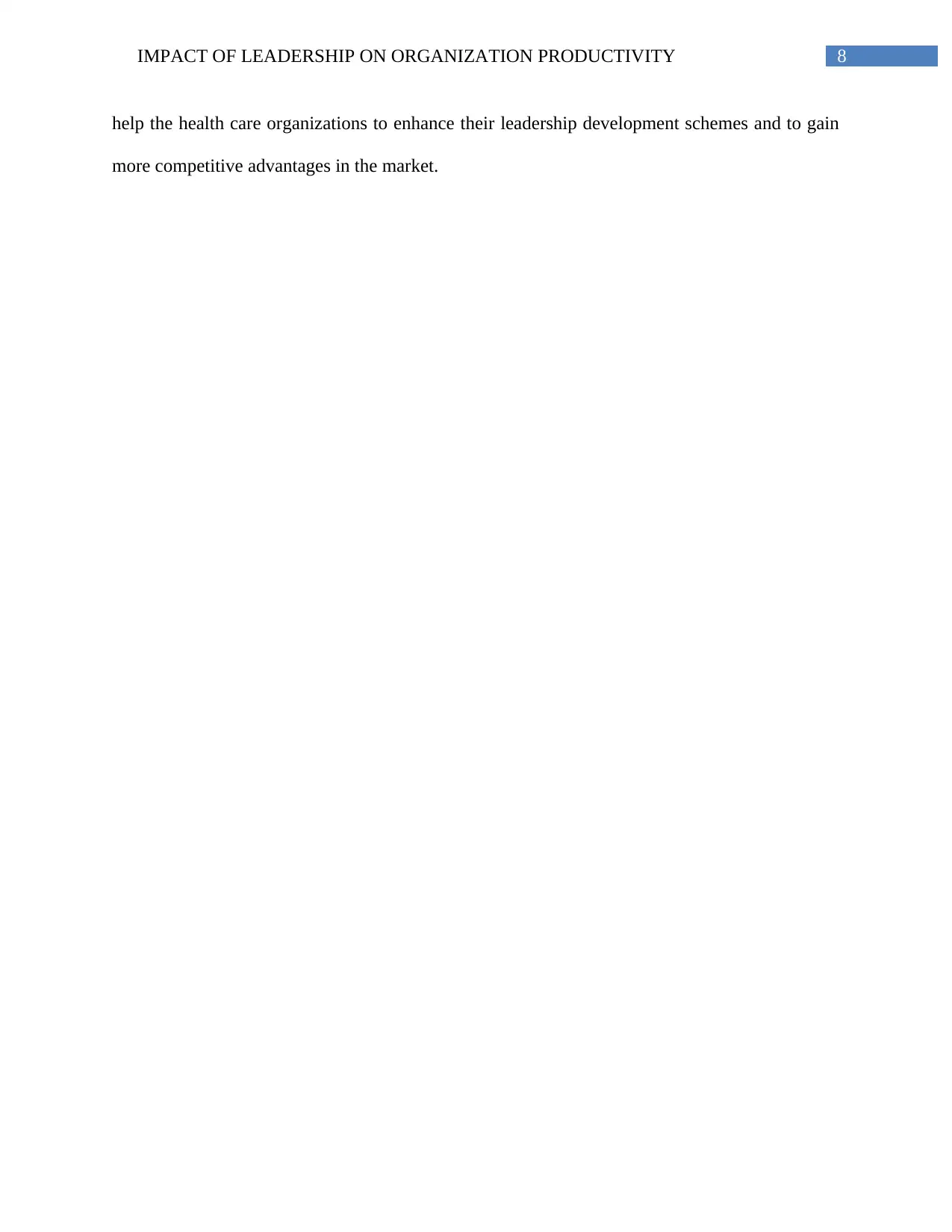
8IMPACT OF LEADERSHIP ON ORGANIZATION PRODUCTIVITY
help the health care organizations to enhance their leadership development schemes and to gain
more competitive advantages in the market.
help the health care organizations to enhance their leadership development schemes and to gain
more competitive advantages in the market.
⊘ This is a preview!⊘
Do you want full access?
Subscribe today to unlock all pages.

Trusted by 1+ million students worldwide
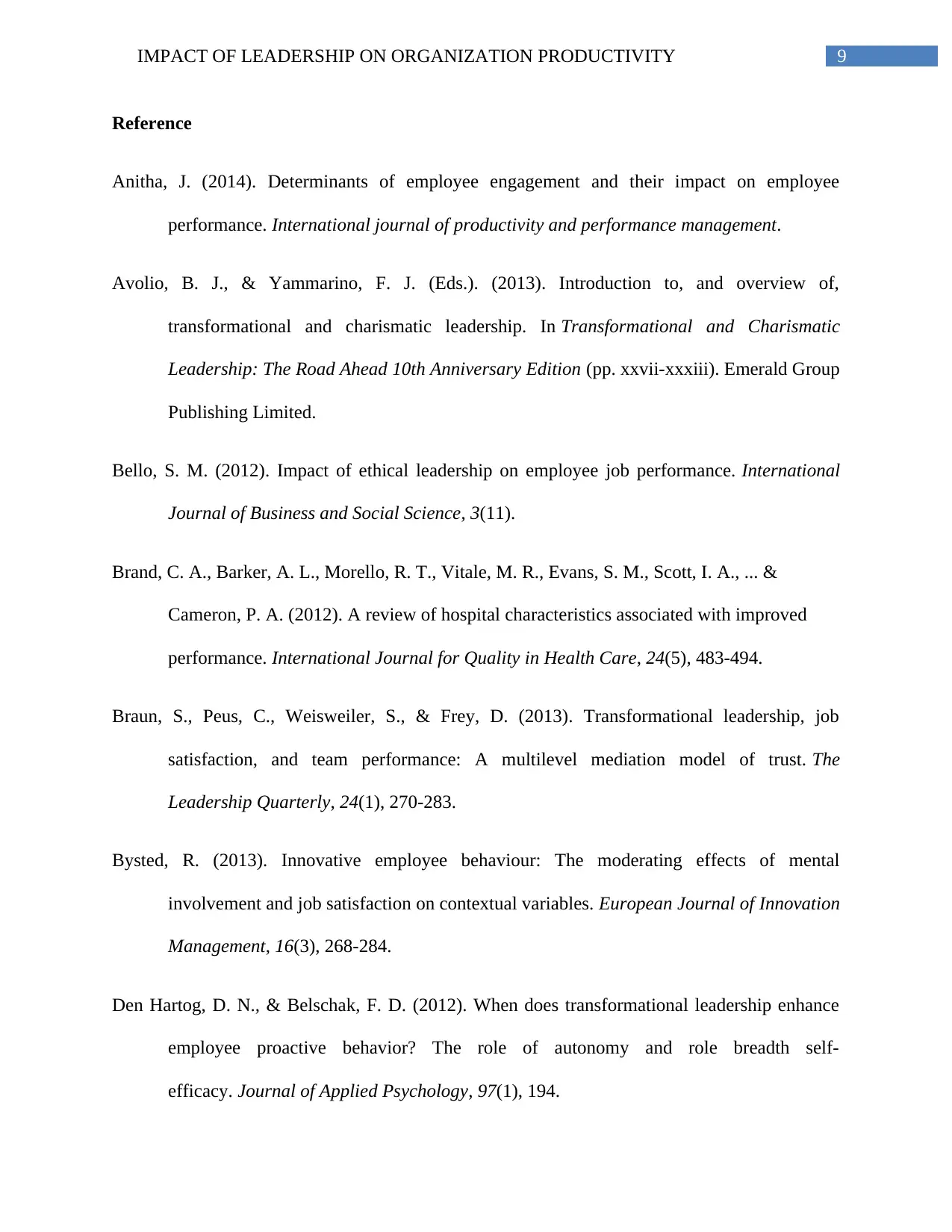
9IMPACT OF LEADERSHIP ON ORGANIZATION PRODUCTIVITY
Reference
Anitha, J. (2014). Determinants of employee engagement and their impact on employee
performance. International journal of productivity and performance management.
Avolio, B. J., & Yammarino, F. J. (Eds.). (2013). Introduction to, and overview of,
transformational and charismatic leadership. In Transformational and Charismatic
Leadership: The Road Ahead 10th Anniversary Edition (pp. xxvii-xxxiii). Emerald Group
Publishing Limited.
Bello, S. M. (2012). Impact of ethical leadership on employee job performance. International
Journal of Business and Social Science, 3(11).
Brand, C. A., Barker, A. L., Morello, R. T., Vitale, M. R., Evans, S. M., Scott, I. A., ... &
Cameron, P. A. (2012). A review of hospital characteristics associated with improved
performance. International Journal for Quality in Health Care, 24(5), 483-494.
Braun, S., Peus, C., Weisweiler, S., & Frey, D. (2013). Transformational leadership, job
satisfaction, and team performance: A multilevel mediation model of trust. The
Leadership Quarterly, 24(1), 270-283.
Bysted, R. (2013). Innovative employee behaviour: The moderating effects of mental
involvement and job satisfaction on contextual variables. European Journal of Innovation
Management, 16(3), 268-284.
Den Hartog, D. N., & Belschak, F. D. (2012). When does transformational leadership enhance
employee proactive behavior? The role of autonomy and role breadth self-
efficacy. Journal of Applied Psychology, 97(1), 194.
Reference
Anitha, J. (2014). Determinants of employee engagement and their impact on employee
performance. International journal of productivity and performance management.
Avolio, B. J., & Yammarino, F. J. (Eds.). (2013). Introduction to, and overview of,
transformational and charismatic leadership. In Transformational and Charismatic
Leadership: The Road Ahead 10th Anniversary Edition (pp. xxvii-xxxiii). Emerald Group
Publishing Limited.
Bello, S. M. (2012). Impact of ethical leadership on employee job performance. International
Journal of Business and Social Science, 3(11).
Brand, C. A., Barker, A. L., Morello, R. T., Vitale, M. R., Evans, S. M., Scott, I. A., ... &
Cameron, P. A. (2012). A review of hospital characteristics associated with improved
performance. International Journal for Quality in Health Care, 24(5), 483-494.
Braun, S., Peus, C., Weisweiler, S., & Frey, D. (2013). Transformational leadership, job
satisfaction, and team performance: A multilevel mediation model of trust. The
Leadership Quarterly, 24(1), 270-283.
Bysted, R. (2013). Innovative employee behaviour: The moderating effects of mental
involvement and job satisfaction on contextual variables. European Journal of Innovation
Management, 16(3), 268-284.
Den Hartog, D. N., & Belschak, F. D. (2012). When does transformational leadership enhance
employee proactive behavior? The role of autonomy and role breadth self-
efficacy. Journal of Applied Psychology, 97(1), 194.
Paraphrase This Document
Need a fresh take? Get an instant paraphrase of this document with our AI Paraphraser
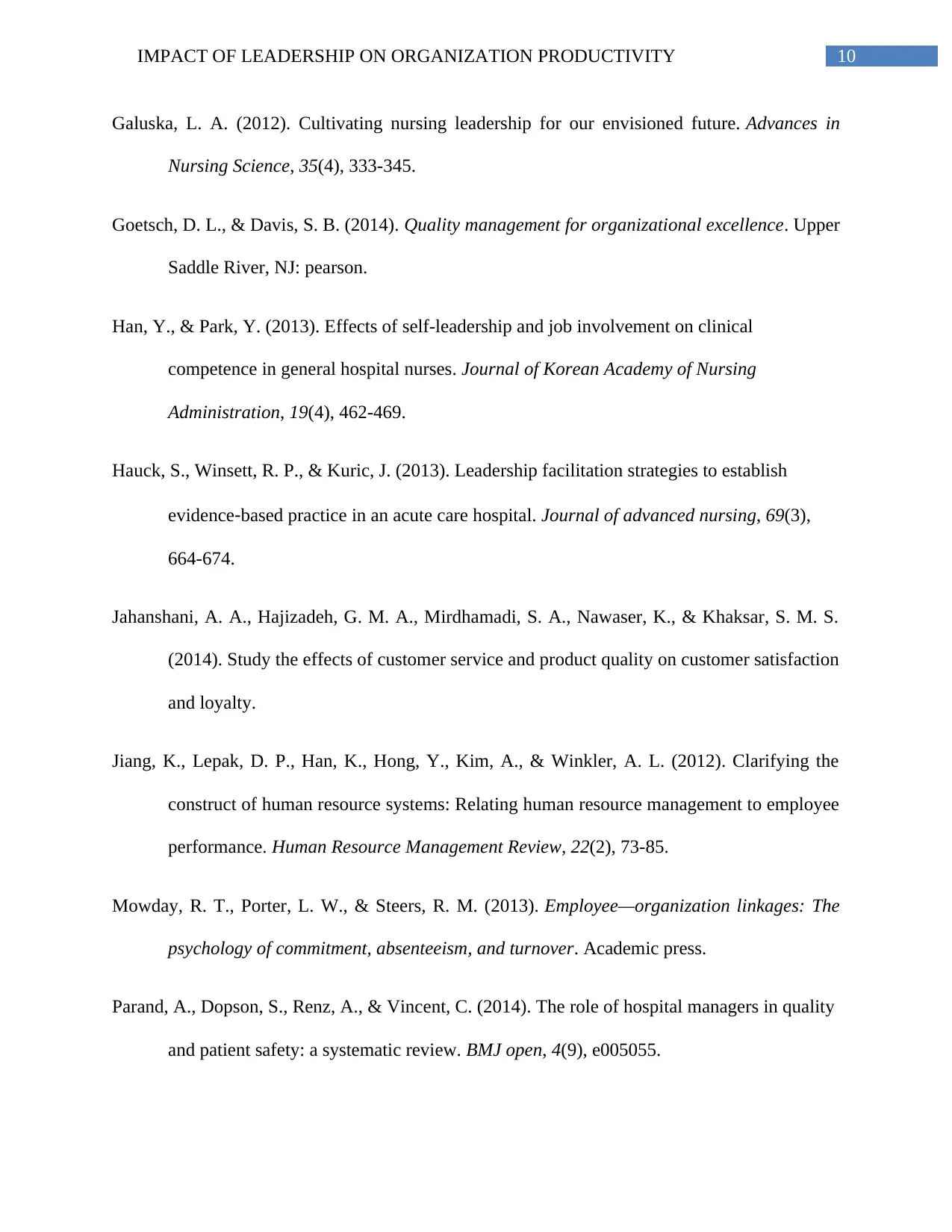
10IMPACT OF LEADERSHIP ON ORGANIZATION PRODUCTIVITY
Galuska, L. A. (2012). Cultivating nursing leadership for our envisioned future. Advances in
Nursing Science, 35(4), 333-345.
Goetsch, D. L., & Davis, S. B. (2014). Quality management for organizational excellence. Upper
Saddle River, NJ: pearson.
Han, Y., & Park, Y. (2013). Effects of self-leadership and job involvement on clinical
competence in general hospital nurses. Journal of Korean Academy of Nursing
Administration, 19(4), 462-469.
Hauck, S., Winsett, R. P., & Kuric, J. (2013). Leadership facilitation strategies to establish
evidence‐based practice in an acute care hospital. Journal of advanced nursing, 69(3),
664-674.
Jahanshani, A. A., Hajizadeh, G. M. A., Mirdhamadi, S. A., Nawaser, K., & Khaksar, S. M. S.
(2014). Study the effects of customer service and product quality on customer satisfaction
and loyalty.
Jiang, K., Lepak, D. P., Han, K., Hong, Y., Kim, A., & Winkler, A. L. (2012). Clarifying the
construct of human resource systems: Relating human resource management to employee
performance. Human Resource Management Review, 22(2), 73-85.
Mowday, R. T., Porter, L. W., & Steers, R. M. (2013). Employee—organization linkages: The
psychology of commitment, absenteeism, and turnover. Academic press.
Parand, A., Dopson, S., Renz, A., & Vincent, C. (2014). The role of hospital managers in quality
and patient safety: a systematic review. BMJ open, 4(9), e005055.
Galuska, L. A. (2012). Cultivating nursing leadership for our envisioned future. Advances in
Nursing Science, 35(4), 333-345.
Goetsch, D. L., & Davis, S. B. (2014). Quality management for organizational excellence. Upper
Saddle River, NJ: pearson.
Han, Y., & Park, Y. (2013). Effects of self-leadership and job involvement on clinical
competence in general hospital nurses. Journal of Korean Academy of Nursing
Administration, 19(4), 462-469.
Hauck, S., Winsett, R. P., & Kuric, J. (2013). Leadership facilitation strategies to establish
evidence‐based practice in an acute care hospital. Journal of advanced nursing, 69(3),
664-674.
Jahanshani, A. A., Hajizadeh, G. M. A., Mirdhamadi, S. A., Nawaser, K., & Khaksar, S. M. S.
(2014). Study the effects of customer service and product quality on customer satisfaction
and loyalty.
Jiang, K., Lepak, D. P., Han, K., Hong, Y., Kim, A., & Winkler, A. L. (2012). Clarifying the
construct of human resource systems: Relating human resource management to employee
performance. Human Resource Management Review, 22(2), 73-85.
Mowday, R. T., Porter, L. W., & Steers, R. M. (2013). Employee—organization linkages: The
psychology of commitment, absenteeism, and turnover. Academic press.
Parand, A., Dopson, S., Renz, A., & Vincent, C. (2014). The role of hospital managers in quality
and patient safety: a systematic review. BMJ open, 4(9), e005055.
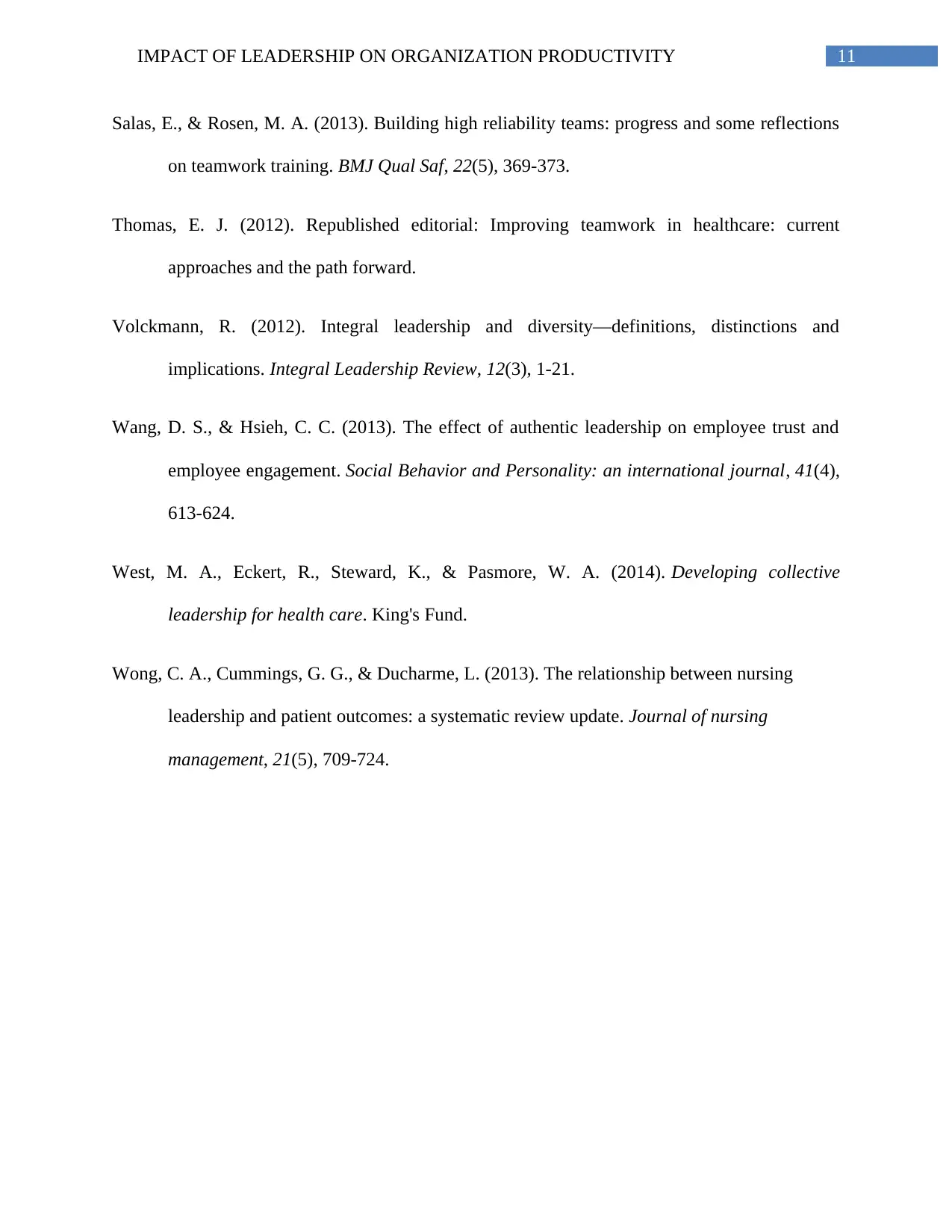
11IMPACT OF LEADERSHIP ON ORGANIZATION PRODUCTIVITY
Salas, E., & Rosen, M. A. (2013). Building high reliability teams: progress and some reflections
on teamwork training. BMJ Qual Saf, 22(5), 369-373.
Thomas, E. J. (2012). Republished editorial: Improving teamwork in healthcare: current
approaches and the path forward.
Volckmann, R. (2012). Integral leadership and diversity—definitions, distinctions and
implications. Integral Leadership Review, 12(3), 1-21.
Wang, D. S., & Hsieh, C. C. (2013). The effect of authentic leadership on employee trust and
employee engagement. Social Behavior and Personality: an international journal, 41(4),
613-624.
West, M. A., Eckert, R., Steward, K., & Pasmore, W. A. (2014). Developing collective
leadership for health care. King's Fund.
Wong, C. A., Cummings, G. G., & Ducharme, L. (2013). The relationship between nursing
leadership and patient outcomes: a systematic review update. Journal of nursing
management, 21(5), 709-724.
Salas, E., & Rosen, M. A. (2013). Building high reliability teams: progress and some reflections
on teamwork training. BMJ Qual Saf, 22(5), 369-373.
Thomas, E. J. (2012). Republished editorial: Improving teamwork in healthcare: current
approaches and the path forward.
Volckmann, R. (2012). Integral leadership and diversity—definitions, distinctions and
implications. Integral Leadership Review, 12(3), 1-21.
Wang, D. S., & Hsieh, C. C. (2013). The effect of authentic leadership on employee trust and
employee engagement. Social Behavior and Personality: an international journal, 41(4),
613-624.
West, M. A., Eckert, R., Steward, K., & Pasmore, W. A. (2014). Developing collective
leadership for health care. King's Fund.
Wong, C. A., Cummings, G. G., & Ducharme, L. (2013). The relationship between nursing
leadership and patient outcomes: a systematic review update. Journal of nursing
management, 21(5), 709-724.
⊘ This is a preview!⊘
Do you want full access?
Subscribe today to unlock all pages.

Trusted by 1+ million students worldwide
1 out of 12
Related Documents
Your All-in-One AI-Powered Toolkit for Academic Success.
+13062052269
info@desklib.com
Available 24*7 on WhatsApp / Email
![[object Object]](/_next/static/media/star-bottom.7253800d.svg)
Unlock your academic potential
Copyright © 2020–2025 A2Z Services. All Rights Reserved. Developed and managed by ZUCOL.




